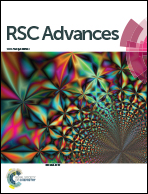Azeotrope enabled polymerization of ethylene oxide
Abstract
Poly(ethylene oxide) (PEO) is a nonionic hydrophilic polymer having the same repeat unit as poly(ethylene glycol) (PEG), distinguished from PEG only by mass or synthetic approach. It is of interest in both biology and materials science, as PEO surfaces demonstrate a unique lack of protein adhesion and PEO block copolymers are widely used in applications such as drug delivery. However, the synthesis of PEO can be experimentally challenging, requiring air sensitive organometallic reagents to form reactive potassium alkoxides followed by the removal of compounds such as naphthalene from the final product. Here we report a synthetic route that avoids these difficulties by forming the propagating alkoxides by azeotropic distillation, removing water from the alcohol/alkoxide equilibrium. Removing the water drives the equilibrium to the potassium alkoxide without the use of pyrophoric organometallics. GPC and NMR are used to characterize the PEO polymers made by this approach from various alcohols, including hydroxyl terminated PEO.


 Please wait while we load your content...
Please wait while we load your content...